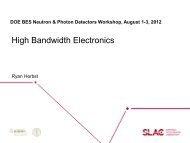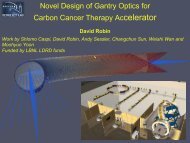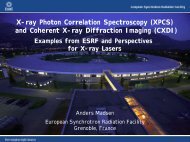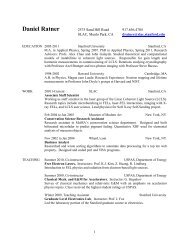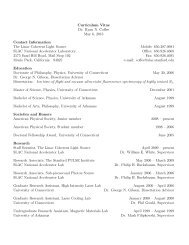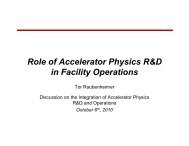SXR Technical Design Report - Stanford University
SXR Technical Design Report - Stanford University
SXR Technical Design Report - Stanford University
Create successful ePaper yourself
Turn your PDF publications into a flip-book with our unique Google optimized e-Paper software.
5.13 Optical Pump Laser Transport, collinear in-coupling<br />
Optical femto second Laser pulses to excite or probe ultra fast dynamical processes have be guided from<br />
the existing Near Experimental Hall optical laser facility (W. White) to the two sample interaction points,<br />
transmission sample chamber and end station. The pump laser will be transported to optical table adjacent<br />
to in-couple mirrors just up stream of each sample location. Focusing and pointing optics and feedback<br />
will be located out-of-vacuum. This allows for flexibility in bringing the laser beam in coaxially or near<br />
coaxially with the Hamburg in-coupling mirror system, described below, or though an off axis viewport.<br />
The nominal set up will have the laser bean brought in though the Hamburg in-coupling mirror with a<br />
~1mm spot size at the transmission sample position and ≥100μm spot at the end station.<br />
The design is based on the Hamburg design used at the FLASH PG2 beam line. It has 2 inch diameter<br />
dielectric plane mirrors with a central bore to transmit the X-ray beam. For different wavelengths specific<br />
mirrors are mounted on a ball bearing stabilized manual translation stage. At 2 inch diameter and a central<br />
bore diameter of 2 mm minimum distortion of the optical wave front is ensured. In the initial stage 800 nm<br />
and 400 nm mirrors are used. The mirrors are in vacuum mounted in spring mounted holders, which allow<br />
bake out of the UHV system without putting mechanical stress onto the mirror surfaces. On the back of the<br />
mirrors matching fluorescence screens are mounted which allow rapid positioning of the X-ray beam<br />
through the central bore.<br />
In this implementation the mirror chamber is fixed with the pointing feed back done out of vacuum. In the<br />
case of the transmission sample position, with the large spot size the pointing stability is not critical so the<br />
in-coupling mirror and the pointing feed back loops are supported separately. At the end station with the<br />
potentially small spot size the in-coupling mirror and the feedback loops and focusing optics will be<br />
mounted on the same optical table.<br />
Figure 5.5 The operational design at the PG2 beam line at the Free Electron Laser at Hamburg (FLASH)<br />
facility.<br />
28



